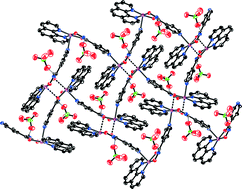Copper(ii) complexes of 3- and 4-picolinehydroxamic acids: from mononuclear compounds to 1D- and 2D-coordination polymers†
Abstract
A series of copper(II) complexes with 3- and 4-picolinehydroxamic acids has been synthesized and characterized by a variety of spectroscopic methods, X-ray structure analysis and magnetic susceptibility measurements. The ligands show the tendency to form 1D- and 2D-polymeric structures with copper(II) ions due to the chelating-and-bridging binding mode involving the (O,O′)-hydroxamate chelate formation combined with N-coordination of the pyridine moiety. In some cases the (O, μ2-O′) chelating-and-bridging modes are realized, in which either amide or hydroxamic oxygen atoms play a μ2-bridging role. Molecular and crystal structures of two discrete complexes: mononuclear [Cu(3-HPicHA)2(ClO4)2] (1) and binuclear [{Cu(4-HPicHA)(bpy)(ClO4)}2](ClO4)2 (4a), and five coordination polymers catena-[Cu(3-PicHA)(phen)]n(ClO4)n (7), catena-[Cu(4-PicHA)(bpy)]n(OH)n·3.25nH2O (8), catena-[Cu(4-PicHA)(DMSO)2]2n(ClO4)2n (9), [Cu(3-PicHA)(DMSO)(ClO4)]nm·nmDMSO (10), and [{Cu(4-PicHA)(phen)}2]n(ClO4)2n (11) were determined by single crystal X-ray analysis. In structures 1 and 4a the hydroxamate ligands exist in a zwitterionic form with the O-deprotonated hydroxamate groups and protonated pyridine rings. The following types of coordination polymers have been structurally characterized: (i) single-stranded zigzag-shaped 1D polymers (7 and 8); (ii) double-stranded 1D polymer comprising binuclear subunits formed on account of μ2(O)-carbonyl oxygen bridging coordination to the axial position of the copper(II) ion (9); (iii) 2D netted coordination polymers of two different types comprising μ2(O)-bridged binuclear subunits (10 and 11). Magnetic susceptibility measurements (2–300 K) of powdered samples revealed the presence of moderate antiferromagnetic interaction in the binuclear complex 4a (2J = −7.164(6) cm−1), while the coordination polymers exhibit weak antiferromagnetic interaction with a cryomagnetic behaviour obeying the Curie–Weiss law.


 Please wait while we load your content...
Please wait while we load your content...